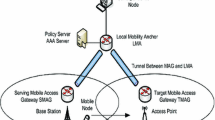Abstract
The coupling of signaling protocols for mobility management and resource reservation plays an important role to achieve Quality-of-Service (QoS) in wireless environments. When performing a handover, request and allocation of resources have to be done in the shortest possible time to avoid disruptions for the user service. Therefore, it is preferable to ensure resource availability in advance, which we call anticipated handover. This approach for providing seamless handovers in turn poses challenges for the overall design of the QoS architecture and its associated QoS signaling protocol. This article describes the design, implementation, and evaluation of a comprehensive QoS architecture and a suitable QoS signaling protocol. It discusses intrinsic problems of reservations in IP based networks such as session ownership as well as a number of protocol design issues regarding the integration of QoS signaling with other protocols, such as Mobile IP. In particular, we define an end-to-end QoS architecture and a mobility-aware reservation signaling protocol Mobility Aware Reservation Signaling Protocol (MARSP) that supports anticipated handover, thus enabling seamless services over heterogeneous wireless access networks. The presented architecture and protocol were implemented and evaluated by measurements. They show that anticipated handovers not only outperform hard handovers regarding handover latency, but that they also provide functional and robustness advantages.
Similar content being viewed by others
References
Blake, S., Black, D., Carlson, M., Davies, E., Wang, Z., & Weiss, W. (1998). An Architecture for Differentiated Service. RFC 2475 (Informational), Dec. 1998. Updated by RFC 3260.
Bless R. (2004). Dynamic aggregation of reservations for internet services. Telecommunication Systems (Modeling, Analysis, Design and Management), Kluwer 26(1): 33–52
Bless R., Hillebrand J., Prehofer C., Zitterbart M. (2004). Quality-of-service signaling for next generation IP-based mobile networks. IEEE Communications Magazine 42(6): 72–79
Bless, R., Hillebrand, J., Prehofer, C., & Zitterbart, M. (2005). Quality-of-service management for IP-based mobile networks. In Proceedings of WCNC 2005, New Orleans, Mar. 2005.
Braden, R., Clark, D., & Shenker, S. (1994). Integrated Services in the Internet Architecture: An Overview. RFC 1633 (Informational), June 1994.
Braden, R., Zhang, L., Berson, S., Herzog, S., & Jamin, S. (1997). Resource ReSerVation Protocol (RSVP)—Version 1 Functional Specification. RFC 2205 (Proposed Standard), Sept. 1997. Updated by RFCs 2750, 3936.
Campbell, A., Gomez, J., Kim, S., & Wan, C.-Y. (2002). Comparison of IP micromobility protocols. IEEE Wireless Communications Magazine, 9(1).
Engel T., Granzer H., Koch B., Winter M., Sampatakos P., Venieris I., Hussmann H., Ricciato F., Salsano S. (2003). AQUILA: Adaptive resource control for QoS using an IP-based layered architecture. IEEE Communications Magazine 41: 46–53
EuQoS (2006). Euqos—end-to-end quality of service support over heterogeneous networks. http://www.euqos.org/, 2006. Integrated Project.
Gallon, C., & Schelen, O. (2005). Bandwidth Management in Next Generation Packet Networks. Technical report, MultiService Forum, Aug. 2005. http://www.msforum.org/techinfo/reports/MSF-TR-ARCH-005-FINAL.pdf.
Hancock, R., Karagiannis, G., Loughney, J., & den Bosch, S. V. (2005). Next Steps in Signaling (NSIS): Framework. RFC 4080 (Informational), June 2005.
Johnson, D., Perkins, C., & Arkko, J. (2004). Mobility Support in IPv6. RFC 3775 (Proposed Standard), June 2004.
Manner, J., & Fu, X. (2005). Analysis of existing quality-of-service signaling protocols. RFC 4094 (Informational), May 2005.
Manner, J., Karagiannis, G., & McDonald, A. (2006). Nslp for quality-of-service signaling, Mar 2007. IETF Internet-draft draft-ietf-nsis-qos-nslp-13 (work in progress).
Manner J., Lopez A., Mihailovic A., Velayos H., Hepworth E., Khouaja Y. (2002). Evaluation of mobility and QoS interaction. Computer Networks, Elsevier Science Publisher 38: 137–163
Marques V., Aguiar R.L., Garcia C., Moreno J. I., Beaujean C., Melin E., Liebsch M. (2003). An IP-Based QoS architecture for 4G operator scenarios. IEEE Wireless Communications 10(3): 54–62
MIPL Mobile IPv6 for Linux. http://www.mobile-ipv6.org, 2006.
Moon B., Aghvami H. (2002). Reliable RSVP path reservation for multimedia communications under an IP micromobility scenario. IEEE Wireless Communications 9(5): 93–99
Mykoniati E., Charalampous C., Georgatsos P., Damilatis T., Goderis D., Trimintzios P., Pavlou G., Griffin D. (2003). Admission control for providing QoS in DiffServ IP networks: The TEQUILA approach. IEEE Communications Magazine 41(1): 38–44
Narten, T., Nordmark, E., & Simpson, W. (1998). Neighbor Discovery for IP Version 6 (IPv6). RFC 2461 (Draft Standard), Dec. 1998.
Nichols, K., Jacobson, V., & Zhang, L. (1999). A Two-bit Differentiated Services Architecture for the Internet. RFC 2638 (Informational), July 1999.
Next Steps in Signaling (NSIS) Charter (2006). http://www.ietf.org/html.charters/nsis-charter.html.
Perkins, C. (2002). Mobile IP. IEEE Communications Magazine, May 2002.
Prior, R., Sargento, S., Gomes, D., & Aguiar, R. L. (2005). Heterogeneous signaling framework for end-to-end qos support in next generation networks. In HICSS ’05: Proceedings of the proceedings of the 38th annual hawaii international conference on System Sciences (HICSS’05)—Track 9 (p. 305.3). Washington, DC, USA. IEEE Computer Society.
Schelen, O., & Pink, S. (2005). Resource sharing in advance reservation agents. Journal of High Speed Networks, Special issue on Multimedia Networking, 7(3–4).
Talukdar A., Badrinathm B., Acharya A. (2001). MRSVP: A resource reservation protocol for an integrated services network with mobile hosts. Wireless Networks, Kluwer 7: 5–19
Author information
Authors and Affiliations
Corresponding author
Additional information
Authors Hillebrand and Prehofer changed their affiliation in the meantime, the work described in this paper was carried out during their employment at DoCoMo Communications Laboratories Europe.
Rights and permissions
About this article
Cite this article
Bless, R., Hillebrand, J., Prehofer, C. et al. A quality-of-service signaling architecture for seamless handover support in next generation, IP-based mobile networks. Wireless Pers Commun 43, 817–835 (2007). https://doi.org/10.1007/s11277-007-9260-9
Received:
Accepted:
Published:
Issue Date:
DOI: https://doi.org/10.1007/s11277-007-9260-9




